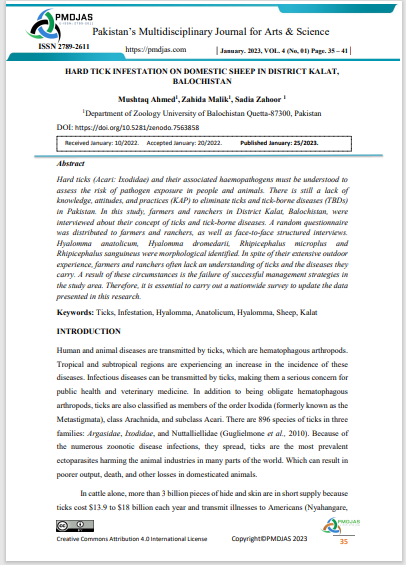Hard Tick Infestation on Domestic Sheep in District Kalat, Balochistan
DOI:
https://doi.org/10.5281/zenodo.7563858%20Keywords:
Ticks, Infestation, Hyalomma, Anatolicum, Sheep, KalatAbstract
Hard ticks (Acari: Ixodidae) and their associated haemopathogens must be understood to assess the risk of pathogen exposure in people and animals. There is still a lack of knowledge, attitudes, and practices (KAP) to eliminate ticks and tick-borne diseases (TBDs) in Pakistan. In this study, farmers and ranchers in District Kalat, Balochistan, were interviewed about their concept of ticks and tick-borne diseases. A random questionnaire was distributed to farmers and ranchers, as well as face-to-face structured interviews. Hyalomma anatolicum, Hyalomma dromedarii, Rhipicephalus microplus and Rhipicephalus sanguineus were morphological identified. In spite of their extensive outdoor experience, farmers and ranchers often lack an understanding of ticks and the diseases they carry. A result of these circumstances is the failure of successful management strategies in the study area. Therefore, it is essential to carry out a nationwide survey to update the data presented in this research.
Downloads
References
Abbasi, F., Abbasi, I. H. R., Nissa, T. F., Bhutto, Z. A., Arain, M. A., Soomro, R. N., Siyal, F. A., & Fazlani, S. A. (2017). Epidemiological study of tick infestation in buffalo of various regions of district Khairpur, Pakistan. Vet World, 10(6), 688-694.
Ahmad, Z., Anwar, Z., Adnan, M., Imtiaz, N., Rashid, H. U., & Gohar, F. (2019). Collection and prevalence of ticks in cattles and buffaloes from free-range management systems of Islamabad. The Journal of Basic and Applied Zoology, 80(1), 1-4.
Asmaa, N.M., ElBably, M.A., Shokier, K.A., 2014. Studies on prevalence, risk indicators and control options for tick infestation in ruminants. Beni-Suef. University Journal of Basic and Applied Sciences 3, 68-73.
Garcia-Vozmediano, A., Giglio, G., Ramassa, E., Nobili, F., Rossi, L., Tomassone, L., 2020. Dermacentor marginatus and Dermacentor reticulatus, and their infection by SFG Rickettsiae and Francisella-like endosymbionts, in mountain and periurban habitats of Northwestern Italy. Veterinary sciences, 7, 157.
Guglielmone, A.A., Robbins, R.G., Apanaskevich, D.A., Petney, T.N., Estrada-Peña, A., Horak, I.G., 2014. The hard ticks of the world. Springer, Dordrecht, 10, 978-994.
Hoogstraal, H., Kaiser, M.N., 1959. Observations on Egyptian Hyalomma ticks (Ixodoidea, Ixodidae). 5. Biological notes and differences in identity of H. anatolicum and its subspecies anatolicum Koch and excavatum Koch among Russian and other workers. Identity of H. lusitanicum Koch. Annals of the Entomological Society of America, 52, 243-261.
Kocan, K.M., de la Fuente, J., Coburn, L.A., 2015. Insights into the development of Ixodes scapularis: a resource for research on a medically important tick species. Parasites & Vectors, 8, 592.
Lew-Tabor, A., Valle, M.R., 2016. A review of reverse vaccinology approaches for the development of vaccines against ticks and tick borne diseases. Ticks and tick-borne diseases, 7, 573-585.
Low, V.L., Tay, S.T., Kho, K.L., Koh, F.X., Tan, T.K., Lim, Y.A.L., Ong, B.L., Panchadcharam, C., Norma-Rashid, Y., Sofian-Azirun, M., 2015. Molecular characterisation of the tick Rhipicephalus microplus in Malaysia: new insights into
the cryptic diversity and distinct genetic assemblages throughout the world. Parasites & Vectors, 8, 341.
Parola, P., Socolovschi, C., Jeanjean, L., Bitam, I., Fournier, P.-E., Sotto, A., Labauge, P., Raoult, D., 2008. Warmer Weather Linked to Tick Attack and Emergence of Severe Rickettsioses. PLOS Neglected Tropical Diseases, 2, e338.
Rafique, N., Kakar, A., Iqbal, A., Masood, Z., Razzaq, W., 2015. Identification of Three Species of Ticks Hyalomma anatolicum Anatolicum, Hyalomma aegyptium and Dermacenter andersoni in Quetta Cityof Balochistan, Pakistan. Global Veterinaria 14, 842-847.
Ramzan, M., Naeem-Ullah, U., Masood Bokhari, S.H., Saba, S., Khan, K.A., Saeed, S., 2020. Checklist of the tick (Acari: Argasidae, Ixodidae) species of Pakistan. Vet Ital, 56, 221-236.
Rehman, A., Nijhof, A.M., Sauter-Louis, C., Schauer, B., Staubach, C., Conraths, F.J., 2017. Distribution of ticks infesting ruminants and risk factors associated with high tick prevalence in livestock farms in the semi-arid and arid agro-ecological zones of Pakistan. Parasites & Vectors 10, 190.
Sarwar, M. (2017). Status of argasid (soft) ticks (Acari: Parasitiformes: Argasidae) in relation to transmission of human pathogens. International Journal of Vaccines and Vaccination, 4(4), 00089.
Walker, A.R., 2003. Ticks of domestic animals in Africa: a guide to identification of species.
Bioscience Reports Edinburgh.
Walker, J.B., Keirans, J.E., Horak, I.G., 2005. The genus Rhipicephalus (Acari, Ixodidae):
a guide to the brown ticks of the world. Cambridge University Press.






